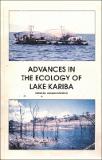| dc.contributor.author | Hustler, Kit | |
| dc.coverage.spatial | Zimbabwe. | en |
| dc.coverage.spatial | Zambia | en |
| dc.date.accessioned | 2016-07-01T14:34:41Z | |
| dc.date.available | 2016-07-01T14:34:41Z | |
| dc.date.issued | 1997 | |
| dc.identifier.citation | Hustler, K. (1997) The ecology of fish eating birds and their impact on the inshore fisheries of Lake Kariba. In: Moreau, J. (ed.) Advances in the ecology of Lake Kariba, pp. 169-218. Harare: UZ Publications. | en |
| dc.identifier.issn | 0-908307-54-3 | |
| dc.identifier.uri | https://opendocs.ids.ac.uk/opendocs/handle/20.500.12413/12040 | |
| dc.description | A research paper on the ecology of fish-eating birds on Lake Kariba and their impact on fish populations within and beyond the lake. | en |
| dc.description.abstract | Most fish-eating species which were present in the middle Zambezi valley before inundation still occur on the lake (Donnelly and Donnelly 1983) and only those which occupied specialized habitats now lost through flooding have disappeared or become scarce and restricted (e g. Rufous-bellied Heron, African Skimmer, Little Bittern). White-breasted Cormorants disappeared from the lake after 1963 but have now returned (Hustler et al. 1986, Hustler 1986a).
Species that have colonized the lake include the Black Egret, Lesser Black- backed Gull, Grey-headed Gull and White-winged Black Tern. The last three species have probably responded to the large areas of open water formed by the lake and the increase in fishing activity (Begg 1973, Hustler 1986b). There is no permanent population of Pelicans on Lake Kariba (Irwin 1981) but small numbers have been recorded periodically in recent years (Hustler 1987). These birds are abundant in shallow lakes such as Lake St. Lucia, South Africa (Whitfield and Cyrus 1978) and Lake Nakuru, Kenya (Vareschi and Jacobs 1984), and are absent from Lake Kariba because there are few suitable shallow areas.
Fish-eating birds on the lake can be divided into residents, migrants and vagrants. It is likely that most resident species have increased in number because of the longer shoreline and greater availability of fish. Intra-African or palearctic migrants may be present for up to six months every year but their numbers vary considerably. | en |
| dc.description.sponsorship | The present investigations were sponsored for many years by the University of Zimbabwe Research Board and by the Swedish Agency for Research Cooperation with Developing Countries (SAREC). | en |
| dc.language.iso | en | en |
| dc.publisher | University of Zimbabwe (UZ) Publications. | en |
| dc.rights.uri | http://creativecommons.org/licenses/by-nc-nd/3.0/ | en |
| dc.subject | Environment | en |
| dc.subject | Science and Society | en |
| dc.subject | Water | en |
| dc.title | The ecology of fish eating birds and their impact on the inshore fisheries of Lake Kariba | en |
| dc.type | Article | en |
| dc.rights.holder | University of Zimbabwe (UZ) | en |


